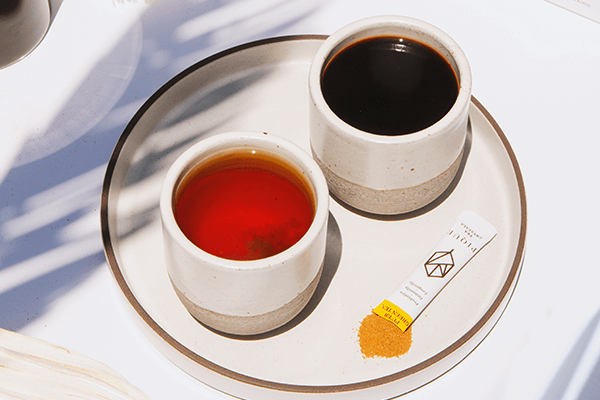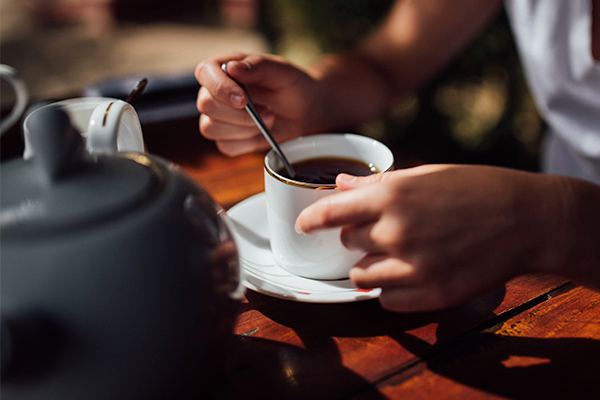If you think “black tea” is just one type of drink – this article is for you! Or if you’ve ever wondered how the many varieties of black tea differ, we’ve got you covered as well.
Have you ever tried a London Fog or an Earl Grey latte? Both are made with black tea.
What you might not know is that “black tea” actually comes in a plethora of types and tastes — all depending on where it’s grown and how it’s processed.
How many types of black tea are there?
There isn’t actually a definitive number of black tea types. Why? The number varies depending on how you classify them. Similar to wine, black tea can be classified by its region, cultivar or character, for example.
In general, black tea can be separated into two categories: flavored tea and unflavored tea.
Flavored black teas (such as Earl Grey) are named based on their style, taste or character. Single-origin, unflavored black teas (like Assam) are named after the region they’re from.

Where does black tea come from?
Black tea is grown and processed all around the world, so you can find varieties from many different climates and altitudes. While you can find black tea from numerous regions, India, China, Sri Lanka and Africa are all known for their black tea production. (China and India are the largest tea producers.)
Each region lends a unique flavor profile to the tea.
What teas are considered black tea?
All true teas (white, green, oolong, black, etc.) can be made from any variety of Camellia Sinensis plants. What makes them all different is how the leaves are processed.
Black tea is typically made from a variety called Camellia Sinensis Assamica. And to get the signature darker brew and bold flavors, black teas are oxidized and then dried.
How is black tea made?
Black tea is made in four steps:
- Wither: After the tea leaves are harvested, they’re spread out in a thin layer for around 10 to 18 hours. Traditionally this process took place outdoors in the sunshine, but many modern tea makers wither their leaves indoors. During this step, the moisture content is reduced but not completely removed. The leaves still need to be pliable.
- Roll: A machine massages the tea leaves, twisting them so the leaf walls break. This helps start the oxidation process.
- Oxidize: After the leaves are rolled, they’re left to rest and oxidize — how long depends on the type of tea and flavors the tea maker is aiming to create. The leaves will turn from light green color to a luxurious brown.
- Dry: When the leaves have oxidized for the desired length of time, they’re put in a dryer. The heat stops the oxidation process, helping to capture the desired flavor and aroma.
From there, it’s packaged and shipped off for consumers to enjoy.
How much caffeine does black tea have?
The caffeine content of black tea falls somewhere between green tea and coffee. On average, each cup of black tea has about 47 mg of caffeine, but it can contain up to 90 mg.

What are the health benefits of black tea?
Like many other types of tea, researchers have found that black tea has multiple health benefits.
Black tea contains healthy antioxidants, L-theanine (a calming amino acid) and beneficial polyphenols. (1) Studies have also shown that black tea supports heart health, gut function, and healthy insulin levels. (2,3,4)
Types of black tea
Black tea is one of the most widely consumed beverages in the world, and (as mentioned earlier) there are numerous types. Here are a few of the more common and unique types of black tea you might come across:
-
- Assam tea is named after its region of origin: Assam, India. It’s known for its malty flavor and reddish color brew. Assam has a bold and intense flavor, so many people prefer to add a sweetener to it. It’s a popular Indian tea and often used in tea blends such as Irish Breakfast tea.
- Keemun is a smooth, somewhat fruity black tea from China. Some people describe it as wine-like in taste and smell. It comes from Qimen in Eastern China. (Keemun is the English spelling for Qimen.) Keemun is a pleasant, rich tea without bitterness. You’ll find that Keemun is used in many English Breakfast blends.
- Darjeeling is considered the “Champagne of teas” by connoisseurs. It comes from the Darjeeling District in India. Its delicate flavor is best enjoyed without milk or other additions. Darjeeling has three harvests a year, and the flavor changes slightly with each.
- Assam tea is named after its region of origin: Assam, India. It’s known for its malty flavor and reddish color brew. Assam has a bold and intense flavor, so many people prefer to add a sweetener to it. It’s a popular Indian tea and often used in tea blends such as Irish Breakfast tea.
- Ceylon teas come from Sri Lanka in an area formerly known as Ceylon. It’s a medium-bodied tea — sweet and somewhat citrusy. Ceylon is good hot or as iced tea.
- Earl Grey is a popular flavored black tea. Oil of bergamot is added to give this tea its unique flavor. The distinct taste makes it a popular tea for lattes, baked goods and candy.
- Nepali is similar to Darjeeling tea, but it’s produced in Nepal. It has a crisp, complex and delicate flavor.
- Yunnan tea is grown in the Chinese Province of Yunnan. It’s fully oxidized and has a sweet and somewhat earthy or smoky flavor. Yunnan tea leaves also have a distinct look: large and dark with bright yellow tips. Typically, a high-quality Yunnan tea will have more yellow tips.
- Nilgiri is an Indian tea from the Nilgiris district. It’s somewhat similar to Assam tea. It’s a bold tea with floral and fruity flavors. The leaves harvested in cooler weather (the “winter frost tea”) are particularly aromatic and flavorful.
- Wuyi is technically an oolong tea from a mountainous area of the Fujian province, but it’s similar to a black tea. Wuyi is heavily oxidized and charcoal-roasted, and (due to the rocky terrain it’s grown in) it has a distinct mineral flavor.

How to prepare black tea
Now that you’ve learned a little more about different types of black tea, here’s how you make it (you can use loose leaf, tea bags, or of course, tea crystals):
- First, make sure that you’re using quality water. You want to use fresh, cold water (and avoid distilled water, which will negatively impact taste).
- Bring the water to a rolling boil. Black teas are substantial so the flavor won’t fully develop if the water isn’t hot enough.
- Steep the tea leaves for around three to five minutes depending on the type of black tea you’re using and your specific taste.
- After steeping, strain the leaves. (You can usually use black tea leaves for multiple steepings, so feel free to save them for another batch.)
- Add milk or sweeteners to taste. (If you’re making iced tea, let the tea cool first.)
A tea for everyone
As you’ve probably guessed, there are plenty of good reasons that black tea is so popular. With so many types of black tea, there’s a variety for almost every taste and situation.
It makes a wonderful drink in the morning or as an afternoon pick-me-up, but due to the caffeine content of black tea, it’s best to avoid drinking it in the evening.






